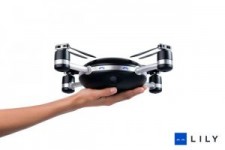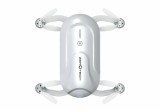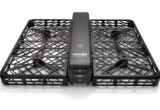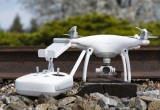DroneCompares Discusses Thinking About Buying a Dobby or Other 'Selfie Drone?' Think Again

Hong Kong, June 17, 2016 (Newswire.com) - DroneCompares revealed there’s nothing more captivating to tech nerds these days than a cute indoor drone that you toss up into the air, have it take a picture of you and your friends, then drops into your hand, folds up and goes back in your pocket.
So-called “selfie drones” are a new and hotly awaited consumer product category, but to date, still one that exists largely on paper. The market has been waiting, and waiting, and waiting, for the Lily drone – the company captured hearts and minds with a viral video in 2015 – but which so far hasn’t actually started shipping.
Lily Selfie Drone
Then there’s “Dobby,” the drone unveiled by China’s ZeroTech and Internet portal Tencent in May 2016. Dobby is a drone that folds up to about the size of an iPhone, weighs 199 grams and features a 13-megapixel camera that can shoot 4K video and stream to your smartphone, which also acts as the drone’s remote control. All that for $290, when it starts to ship in July.
Dobby Selfie Drone
Keyshare Technologies has also been spending a fair amount on Internet advertising and sponsored stories to tout its Kimon selfie-drone, a tiny, 16-megapixel, 4K flying camera, also controlled through a smartphone and capable of taking off and landing with a single touch. Neither shipping date or price has been set yet.
Kimon Selfie Drone
And the Hover Camera from Zero Zero Robotics, which bills itself as “the self-flying camera anyone can use,” has garnered some media attention recently. It will reportedly ship over the summer for somewhere under $600.
Hover Camera
The makers of the four drones are careful to position themselves as the “undrone drones,” focusing attention on how small, cute and convenient the airframes and form factors are. They spend most of their time marketing the selfie capabilities of their drones and how these adorable flying selfie cams fit into nearly every lifestyle situation you can imagine.
At a recent technology conference, a Lily executive went out of his way to emphasize that his forthcoming drone was not aimed at competing with any other drone on the market, insisting it was part of a new, emerging product category that was more selfie-stick than flying machine.
Make no mistake: These new drones are not toys. They each have a built-in flight controller to keep them fairly stable and decent propulsion systems to keep them aloft.
But they’re not yet proven products, let alone an actual product category. Their headline-grabbing appeal is testament to both marketing and advertising messages, as well as the promise so many of us hope the drone sector has.
While pre-launch drone companies are already assiduously segmenting the drone sector, consumers need to consider some actual facts and information before they buy.
Flying selfie cameras sound so cuddly and friendly, but these are drones – just a bit smaller than the ones we’re used to. They have drone parts and components and systems and chipsets in them. And they need to live up to the same performance and reliability standards as every other drone on the market.
And while it’s too early to tell, because nobody has really subjected these wee’uns to the kind of rigorous Wirecutter testing, some claims already beggar belief.
How good are your sensors? To take one example, the most-stable drone on the market right now, the DJI Phantom 4, has two downward-facing cameras that see the ground below down to 10 meters, along with twin ultrasonic sensors that sense the ground down to five meters. To cut through the tech jargon, what this means is that the Phantom 4 is rock-solid stable indoors, even when it doesn’t have a GPS signal from 25 satellites to lock onto. It won’t wobble, shimmy or skirt away when you’re trying to line up a shot.
DJI Phantom 4
If a selfie drone is going to fly stably indoors, it will need to have the same sort of onboard sensors.
Other questions to ask are where the new drone companies and the new drones are sourcing their other sensors, such as the inertial measurement unit (IMU). Are they paying top dollar for miniaturized IMUs? From whom or where? And are they as good as full-sized IMUs in larger drones?
It’s a simple fact that a smaller drone either has smaller or fewer components and sensors. With companies like DJI, with 1,500 engineers on staff, already bumping up against the limits of PCB and component miniaturization, it seems more likely that selfie-drone companies are sacrificing components and added capabilities in exchange for size. There’s also likely no built-in redundancy in these mini-drones, which subtracts some of the added safety and reliability factors makers like DJI are now building into their drones.
We’d have to crack open the hulls or see a teardown before making a final determination.
For the prices some of the new flying selfie cams will cost you, you can and should expect the same or better performance from a full-sized drone. If you want to buy a Lily, the preorder price plus shipping is $919. That’s only $80 less than the Phantom 3 Professional, which has two downward-facing sonic sensors, intelligent flight modes and a top-rated 4K camera, a full remote controller (not just your smartphone) and access to an entire ecosystem of apps being created for drones on the DJI software development kit. And yes, the P3 Pro also takes selfies.
All these drones also use WiFi, which can be fine to transmit a video signal over short distances, but not always and definitely not reliably at over a few hundred feet, should you want to fly out or up a bit. The P3 Pro uses Lightbridge technology that works out to five kilometers, to give you an idea of signal strength.
Yes, your drone might have a 13- or 16-megapixel camera, but how big is the sensor? As many pixels as your camera can capture, if the sensor is small, your image quality is going to take a serious hit in anything but a perfect lighting situation. And how good is a tiny gimbal going to do compared to a more powerful one on a full-sized drone, to ensure maximum image stability.
And then there’s the battery issue. Small drones mean small, lower-capacity batteries. The result is a disappointing 5-10 minutes of flight time in-between recharges. It’s not these companies’ faults. Battery technology currently has limitations, and there’s not much you can do to increase the flying time without increasing battery size.
In contrast, a new Yuneec Typhoon H or a Phantom 4 will give you, respectively, 25 and 28 minutes of flight time in ideal conditions, and well over 20 minutes in non-ideal situations.
Size and form factor also mean your drone may be less aerodynamic and subject to buffeting by weather or environmental factors. A poorly time gust of wind can ruin the perfect camera shot.
The mini-drone-makers might be right. Their most-apt comparison might not be with full-sized drones. It might be with selfie sticks, which are cheaper and offer 100% control over their use, or even tinier toy drones like the Hubsan, which has a gyroscope to offer a modicum of in-flight stability, an OK camera and a price tag of under $100.
At least at first, until the individual drones proves themselves, and the actual new “selfie-drone” product category emerges, your best bet might be to simply wait, buy a toy, buy a selfie stick or a full-sized drone that already performs according to specs and has passed rigorous reviewer and consumer tests.
Hubson X4 107D FPV
President Obama with His Selfie Stick
And ask yourself, “do I really need a ‘selfie drone,’” or will the novelty quickly wear off after a few shots ruined by wind, weather or your inability to remember where you put your tiny battery charger.
DroneCompare has made the article free on its website. It, and other valuable articles on drone technology can be found here
Source: http://www.dronecompares.com/



